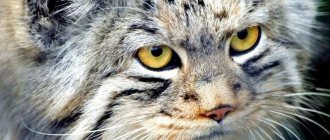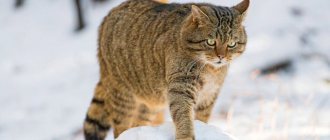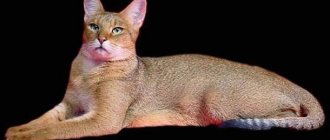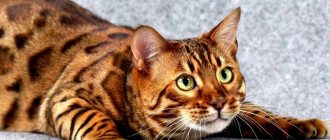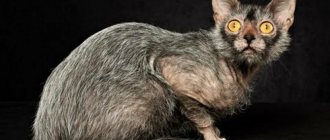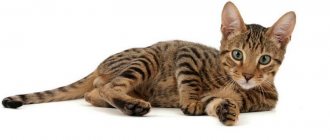This wild cat is known for its extreme unsociability - the Pallas' cat cannot be tamed, living next to a person for many years. Even Pallas cat kittens born in captivity never become tame.
It was discovered and introduced to the world by the German naturalist Peter Palass, who discovered the predator in 1776 near the Caspian Sea, thanks to which the animal received its second name - Pallas's cat.
Of the two scientific names Felis manul and Otocolobus manul, the second one is puzzling, meaning “ugly ear” in Greek (otos - ear, and kolobos - ugly).
Appearance
The Pallas cat is recognized as the smallest wild cat living in the post-Soviet space. With its half-meter length and weight of 2–5 kg, it would resemble an ordinary cat, if not for its characteristic harsh appearance and lush fur, which gives it excessive massiveness. In general, the Pallas' cat seems very dense: the impression is complemented by short, thick limbs and a voluminous, not particularly long (23–31 cm) tail. The claws on the paws are strongly curved.
According to one hypothesis, the Pallas's cat is closely related to Persian cats, which have the same rounded outlines, fluffy hair and an unusual (flattened) head shape. On its sides are wide ears with sideburns of long hair running to the sides.
Pallas's cat has not 30 (like most cats), but 28 teeth, where the fangs are three times longer than those of a domestic cat. The eyes are equipped with developed nictitating membranes: they act as a third eyelid, protecting the cornea from drying out and injury. The Pallas's cat is famous for the wary gaze of its large yellow-green eyes, under which there are 2 black stripes stretched across the cheeks. One ends at the base of the ear, the second - on the neck (under the ear).
This is interesting! The fantastic fluffiness of the Pallas's cat, compared to other cats, is explained by both the height of the hair (7 cm) and the density of its germination - 9 thousand per 1 sq. cm.
Pallas' cats vary slightly in size and color, depending on the subspecies (one of three) and habitat:
- Otocolobus manul manul – has a typical color (lives in most of its range, but is more common in Mongolia and western China);
- Otocolobus manul ferruginea - distinguished by a red-ocher color, with noticeable reddish stripes (lives in Uzbekistan, Iran, Afghanistan, Kyrgyzstan, Kazakhstan, Turkmenistan, Tajikistan and Pakistan);
- Otocolobus manul nigripecta - shows a grayish color, acquiring a silver-gray hue in winter (inhabits Kashmir, Tibet and Nepal).
The standard winter color is formed by light gray and fawn-ocher shades, where gray hair has white endings. The limbs and belly are more red than the back, across which there are 6–7 black stripes running down to the sides. The tail is also ringed with several (up to 7) transverse lines and ends with a black tip.
Character and lifestyle
Manul, like many cats, lives separately and sedentary, without resorting to prolonged migrations. The male “owns” hunting grounds with an area of up to 4 square meters. km., where it sets up a den, choosing secluded places between stones or in crevices. It often occupies the burrows of marmots (tarbagans) and foxes, or digs its own, in remote ravines and under cliffs. It rests in the den for part of the night, devoting the dark time of day to hunting.
More often it appears after sunset, early in the morning or during the day if it happens in the summer. In search of food, the Pallas's cat moves no further than 0.1–1 km from the den, inspecting the nearest fields, steppe and rocks. The method of movement resembles that of a fox, in a straight line and track after track, but with a different interval between round tracks (12–15 cm).
This is interesting! The Pallas' cat's arsenal of sound signals includes a sharp snort and a hoarse rumbling. Pallas's cat, unlike other cats, cannot hiss at all.
The predator does not tolerate intrusion into personal space - in this case it becomes extremely aggressive and uses sharp long fangs.
How long do Pallas' cat live?
According to rough estimates, in the wild the Pallas's cat does not always live to be 11–12 years old, but has a chance of living longer if it gets into a zoological park. Thus, in the Moscow Zoo, one of the Pallas cats lived to be 18 years old. In addition, the Pallas's cat was the symbol of the capital's zoo from 1987 to 2014, and the image of the cat was on the main entrance. But the history of the species in the zoo began much earlier, in 1949, when the first Pallas' cat appeared here.
Already in 1957, animals began to be exhibited constantly, and since 1975, predators began to reproduce regularly. Since that moment, over 140 kittens were born at the zoo, not all of which survived to adulthood, but it was the “Moscow” Pallas’ cat that joined the collections of American and European zoos. The Moscow Zoo is considered the leader in the number of Pallas' cat births, despite the difficulties of reproduction and keeping them in captivity.
Important! When the habitat changes, the manul experiences serious stress, which affects the immune system and overall health. Many individuals, finding themselves in an unfamiliar environment, die due to deadly infections.
It’s too early to talk about stable reproduction of Pallas’ cats in zoos, although some of them have far from the first generation of predators born in captivity. There are brave souls who try to keep Pallas's cat in private houses and apartments, deceived by its external resemblance to a cat. But there are too many factors that make home confinement impossible:
- intolerance to high temperatures (thick wool is designed for severe frosts, down to minus 50 degrees);
- refusal of unfamiliar food;
- a sharp decrease in immunity and susceptibility to disease.
And most importantly, the manul is stubborn and self-sufficient. He will never turn into a tame and will not contact people even after many years.
Description and origin of the species
The first scientific description of the animal was given by the German naturalist Peter Simon Pallas in 1776. He met the animal while traveling in eastern Siberia, and gave the cat its first scientific name Felis manul.
In 1842, Johann-Friedrich von Brandt, a German naturalist working in Russia, proposed placing the animal in a separate genus of Pallas' cat (
Otocolobus
).
Later in 1907, the British zoologist Reginald Innes Poukok finally approved the classification: the animal is the only representative of the monotypic genus of Pallas's cats, and bears the scientific name Otocolobus manul.
The name manul is borrowed from the Kyrgyz language, and translated means “cat” in Kyrgyz. In Mongolian the word sounds a little different, “manol”. The name Pallas' cat was first proposed by the English zoologist William Blanford. Latin genus name Otocolobus
comes from ancient Greek, and literally means dwarf ear.
The closest relative of the animal is the genus Eastern cats (Prionailurus). It includes small predators of the cat family that live exclusively in Asia - the Bengal cat, the Sumatran cat, the fishing cat and the spotted cat. According to mitochondrial DNA analysis, the ancestors of Pallas's cat separated from a common ancestor with eastern cats from 9.4 to 1.46 million years ago.
Distribution and abundance of Pallas' cat
The habitat of all subspecies of the manul cat can be marked on the map as impressive territories. This is all of Central Asia, China, Tibet, Mongolia, the Caspian Lowland, Kashmir, Central Asia and even some lands in Eastern Europe. Russia received an ordinary manul cat , living in the Krasnoyarsk Territory, the Altai Republic, Transbaikalia and Tuva.
The Transcaspian or Central Asian Pallas's cat is a permanent inhabitant of Uzbekistan, Tajikistan, Iran, Kyrgyzstan, Afghanistan, and Pakistan. Only the Tibetan variety prefers to live in Nepal and Tibet.
The accuracy of the numerical quantity is difficult to determine due to the secretive lifestyle of the Pallas’ cat animal, but there are approximately 3,000 of them on the territory of the Russian Federation. There is a noticeable decline in numbers due to poaching and the expansion of economic development of land.
This endangered feline species is listed in the International Red Book, the Red Book of the Russian Federation and received the status of “rare species in its habitat.”
What does a manul look like - size and appearance
Pallas's cat is comparable in size to domestic cats. The body length of the animal is from 46 to 65 cm, the tail length is from 21 to 31 cm. The weight of the cat is on average from 2.5 to 4.5 kg. The animal has a stocky build, short legs and thick long fur, so in appearance the cat seems denser and more massive than it actually is. Pallas's cat has the thickest fur of all cats - there are up to 9,000 hairs per square centimeter, each up to 9 cm long.
The color of the animal varies from light gray to dark yellow, with vertical dark stripes on the body and front legs. In winter, the fur is grayer, and with less pronounced stripes, than in summer. at the ends the hair is painted white, which gives the skin a snow-dusted appearance. Dark rings are clearly visible on the tail, and dark spots on the forehead. On the cheeks, horizontal dark stripes extend from the corners of the eyes to the side. Dark and white circles around the eyes emphasize their round shape. There is light fur on the chin and throat, which smoothly blends into light gray on the belly.
Pallas' cat's paws are proportionally the shortest among all cats. The ears are very small, and low set and fairly wide apart. The muzzle is noticeably shorter than that of other cats, so it seems that the animal is looking from under its brows. Due to its short jaw, the cat has fewer teeth than other wild cats, but has long fangs. The animal has short claws, and unusual round pupils, compared to other felines.
What affects the cost of a British kitten
- The main reason influencing the price of a British kitten is its class. Show class cats are recognized as the most expensive and elite. For one small lump they ask for 15-30 thousand rubles, focusing on age, gender, pedigree, color.
- British breeding class kittens are sold a little cheaper. The price for these pets ranges from 9-15 thousand rubles.
- The most budget option will be the British pet class. A good kitten of this class costs between 3-6 thousand rubles. This cat will make a wonderful pet, but he will definitely need to be spayed/neutered.
- At a reasonable price, it is possible to purchase a purr without documents. Among their representatives there are British, which basically correspond to the breed standards, and those that only partially resemble them.
Not everyone knows how much you can buy a fold-eared kitten from a breeder. Many people want to save money, and in the hope that they will be lucky with a pet, they take a kitten from their hands on a website on the Internet, a bird market, or through an advertisement in a newspaper. However, some later regret it, because the kitten is growing, and it is not a fact that it will correspond to its breed. Flaws in the structure of the body, color, etc. are not excluded. But it is not yet known what kind of character the pet will have?!
Character and lifestyle
Manul, like other wild cats, leads a solitary and sedentary lifestyle. Each animal has its own territory, which they mark with scent marks. The size of its own range varies depending on the habitat and food supply, but no more than 10 square kilometers per predator.
During the day, animals rest in caves, rocky outcrops, former dens of marmots and foxes, and at dawn and in the late afternoon they go hunting. Cats hunt prey from ambush, or sneak up unnoticed, using stones and bushes for cover. The color of the animal perfectly camouflages it among the snow and stones.
Pallas cats are the most clumsy and slow of all wild cats. They are not adapted to running, and chase prey, relying solely on surprise attacks from ambush. In case of danger, they hide, camouflage themselves against the background of stones, and climb onto the rocks.
Peculiarities of Pallas's behavior
Pallas's cat leads a solitary lifestyle and is not prone to moving long distances. Manul makes shelters in rocks, caves, narrow holes, and also occupies burrows left by other animals - badgers, marmots, foxes. This predator behaves very slowly in everyday life, even seeming clumsy and clumsy.
During the day he usually sleeps in the den, and at dusk he goes out hunting. Color helps the animal blend in with its environment and be invisible. Both when hunting and when defending, Manul prefers to hide and wait; he cannot run fast and does not like rapid movements.
It can quite deftly climb rocks and climb into a narrow crevice, where a large predator definitely cannot reach. But Manul practically does not know how to climb trees.
If a cat is alarmed, it emits a characteristic snort or a hoarse rumbling sound.
Such a high level of caution in Pallas's cat is explained by a large number of natural enemies - wolves, wild and feral dogs, eagles, eagle owls, and bears.
The Manul can watch its future prey from ambush for hours, often tracking it at a hole, but the attack on the victim can be swift and unmistakable.
Manul seems gloomy and unfriendly. Indeed, this animal does not really favor even its relatives.
Pallas's cat is perfectly adapted to life in the steppe. The animal is not afraid of dry, frosty wind. The body is protected by long hair with a thick undercoat, and the eyes have special membranes that, due to frequent blinking, protect the cornea from dehydration.
Despite his slowness, the Manul is able to cover a short distance very quickly, but then needs a long sleep. This is due to the small size of the heart sac, due to which the vascular system cannot withstand long-term loads.
The animal's hearing, vision and sense of smell are excellent, so the steppe is its home. He is able to sense danger from afar and hide, crawl into the narrowest crevice, and if necessary, he can defend himself, growling menacingly and showing sharp fangs.
Where does the manul live?
Pallas's cat lives in the steppes of Central Asia. It can be found in the following countries:
- Kazakhstan
- Tajikistan
- Kyrgyzstan
- Iran
- Afghanistan
- Pakistan
- Nepal
- India
- Butane
- Mongolia
- China
- Russia
In Russia, the Pallas's cat lives in the Trans-Baikal Territory, Chita, Altai, the Republic of Tyva and Buryatia. The animal is found in western China. Previously, Pallas's cat also lived in Armenia and Azerbaijan (in 2017 it was seen in the Zangezur National Park of Azerbaijan), but as of 2021, the populations in these countries have been almost completely exterminated.
As a habitat, the Pallas's cat prefers open steppe spaces with low snow cover in winter and a sharply continental climate. It is found in the highlands at an altitude of up to 4,000 meters above sea level - in rocky crevices, rocky outcrops, semi-desert areas of mountains and bush thickets. Practically does not live in forests and lowlands.
Subspecies
Representatives of the population are not particularly diverse in their characteristics and stubbornly pass on their “prehistoric forms” from generation to generation.
Three subspecies are reliably known:
- The Siberian subspecies of Pallas's cat is common in China, Mongolia, Transbaikalia, Altai Territory, and Tyva. The color of the fur is typical, represented by light gray shades, the tips of the fur are white.
- The Tibetan subspecies (common in Nepal, Tibet, Kashmir) is endowed with a darker fur color, has pronounced black spots on the head and stripes on the tail and back. In winter, the coating takes on a silvery tint.
- The Central Asian subspecies of Pallas's cat lives in Iran, Pakistan, Afghanistan, Kyrgyzstan, Kazakhstan, and is distinguished by its reddish-ocher color. The stripes on the body and tail are clear, with a red tint.
What does manul eat?
Pallas's cat feeds mainly on pikas, small birds (Asian mountain partridge), and mice (clawed gerbil, vole). The pika is a small animal belonging to the lagomorphs, the size of a hamster. Less commonly, Pallas's cat hunts tolai hares, gophers and young marmots. In the summer, when there are few pikas, the cat actively eats insects - grasshoppers, locusts, etc.
Origin story
Long years of evolution have had virtually no effect on the appearance of the representatives of the Pallas cat breed: even today they look the same as they did centuries ago. Moreover, this is one of the oldest animals that is currently not fully studied. The origin of the name is also unclear. Only one thing is clear: the word “manul” has Turkic roots. True, the Pallas cat has another name - the Palassov cat. He owes this to the scientist Peter Pallas, who accidentally met a wild forest cat and was the first to describe its way of life back in the 18th century.
Reproduction and young
The mating season for Pallas cats is very short due to the harsh climate in its habitat. Estrus lasts only 26 to 42 hours, which is much shorter than that of other wild cats. Pregnancy lasts from 66 to 75 days, the female usually gives birth in April or May. In a litter, from 2 to 6 kittens are born. Kitten survival rate is quite low (44% of kittens die before 30 days of age), so large litters compensate for high mortality and harsh climate conditions.
Females give birth in a den lined with dry grass, feathers and wool. Crevices, small caves, and old holes of marmots, badgers, and foxes are used as dens. Kittens are born weighing only about 90 grams, blind and helpless, covered with thick fluffy fur, which is replaced by full adult fur at the age of 2 months. From 4 months, the cubs begin to hunt, at 6 months they reach the size of an adult cat and begin an independent life. Puberty in Pallas' cats occurs after 10 months.
Types of ferrets
Before purchasing this animal, you should understand what types of ferrets exist. There are not so many of them, only three, but each species has characteristic distinctive features.
Stepnoy
The steppe ferret is also known as the light-colored, white ferret. You can look at photos of this animal on the Internet, but you cannot see any obvious distinctive features in its appearance.
Main characteristics:
- steppe individuals are large in size. Weighing 2 kilograms, they can grow up to 52-56 centimeters;
- The length of the tail of animals of this species can be about 18 centimeters;
- this species has long guard hairs with a sparse structure;
- The general color is brown, there is an underfur underneath that is dense to the touch, it has a light color.
Forest
They are also called ordinary, black. Animals of this species have small body sizes, its length is only 36-48 centimeters. The weight of an adult can be from 400 grams to one and a half kilograms.
The color of the coat of the black polecat, unlike representatives of the steppe species, does not have sharp contrasts between the color of the legs and the whole body. The main color of the animals is black-brown, and the legs, tail, and chest area are black. Also sometimes there are individuals that are completely white or red in color.
The African ferret or ferret is a domesticated animal that belongs to this species. Sometimes this species is called furo, but scientists use it for albinos. In order to understand what these species look like, you can look at the photo.
The appearance is not very different from representatives of other varieties:
- body length is average, it can be approximately 51 centimeters;
- the weight of the animal can vary from 700 grams to 2 kilograms;
- the length of the tail is 12 centimeters;
- the coloring is the same as that of individuals of the forest species.
Sometimes domesticated ferrets are crossed with wild individuals. Hybrids differ in that they have larger body sizes, but all external features are similar to the characteristics of both species that were used for crossing. The decorative ferret is called honorik. In appearance it is somewhat reminiscent of mink or angora. They have a thick brown underfur that is similar to sable fur. In order to understand exactly what this species looks like, you can look at its photo.
Note! The Angora ferret or Honorik is highly aggressive. These species simply cannot get along with people, for this reason they live only in the wild forest
American
They are also called black-footed ferrets. This is a rare species, which is listed in the Red Data Book in the USA. Every year their number becomes smaller, at the moment they are on the verge of complete extinction. In order to understand what these individuals look like and what differences they have, it is worth looking at photos on the Internet.
Appearance Features:
- The ferret's body size is 31-41 centimeters;
- the weight of individuals ranges from 650 to 1 kilogram;
- the tail has a fluffy edge, its length can be from 11 to 15 cm;
- The main cover is white in color, and the tips of the hairs have a dark color. For this reason, from the outside it seems that the animals have a yellow-brown color.
Ferret breeds have distinctive characteristics that you need to know. On the Internet you can look at photos of animals of a certain species, they will help in the future to distinguish the individual. African individuals are suitable for home breeding; they are most adapted to home conditions and have an easy-going character. But his well-being depends on the necessary care and favorable conditions.
Natural enemies and threats
Pallas's cat is often hunted by wolves and eagle owls. In addition, at a young age the animal is very susceptible to infectious diseases. A serious threat to the animal is snowy winters and prolonged ice, as well as a reduction in food supply - a decrease in the population of rodents, pikas and other prey.
Human actions currently pose a significant threat to the species:
- poachers kill animals for their skins in Mongolia, China and Russia;
- wild cats regularly fall into snares set for marmots and hares, and traps for wolves and foxes;
- animals are often killed by herding and domestic dogs.
Manul in the food chain
The Pallas cat animal is clearly not at the top of the food chain, although it is considered a predator.
This is all due to some of the slowness of the beast, its reluctance to enter into open conflict, and its inability to move quickly.
Cat's food
The animal's diet includes pikas, mouse-like rodents, hamsters, voles, gophers, hares, marmots, and various birds. The cat will happily taste the quail that did not have time to fly away, and in severe times of hunger it will not refuse even a cricket.
The hunting process occurs either in the morning, or in the evening and all night.
The manul cat hides in a place convenient for waiting for the victim, patiently looks out for it, and only then pounces on the careless animal. Short legs are rather a hindrance here, so he has a chance to catch prey suddenly: in a run, a wild cat will lose.
In winter hunting, warm, thick hair together with short limbs makes the cat clumsy, so the animal prefers to forage for food in open, windy spaces.
Enemies of Pallas's cats
global $ads_google;
//data-ad-slot=”2475549904″ $ads_google = empty($ads_google) ? false : true; ?> if ($ads_google == false) {?> $ads_google = true; ?> } ?> The physique and habitat of the wild Pallas's cat makes their existence unsafe. Since cats prefer open spaces, they are open to the view of larger predators, which can be steppe wolves, eagles, golden eagles, and eagle owls. Feral dogs do not miss the opportunity to hunt a fluffy cat.
Nature can also become a serious enemy: if the winter turns out to be snowy, then for cats this means lack of food. Pallas cat kittens that appear by mid-spring can die from infections.
Humans are also considered enemies of the handsome man with a stern expression on his face. People are expanding their own land, making survival conditions more difficult - the food supply is shrinking, and there are more and more stray dogs. Hunters set traps for a hare and a fox, and the unfortunate manula cats .
Population and conservation of the species
It is difficult to calculate the exact number of animals due to the inaccessibility of their habitat and excellent camouflage, but the number of cats is declining everywhere. According to data at the beginning of the 2000s, there were from 3,000 to 3,650 Far Eastern individuals left in Russia, most of them were in the Chita region.
The wild cat is listed as a “species of least concern” by the IUCN Red List and is included in the Russian Red Book. Hunting for Pallas's cat is prohibited in all countries of its habitat except Mongolia.
Since 2013, the Far Eastern Pallas's cat has been studied in the Daursky National Nature Reserve as part of the Russian Geographical Society's program for the conservation of Pallas's cat in Transbaikalia. The main goals of the program are to study the animal's natural habitats and migrations, as well as measure the survival rates of kittens and adults.
As of 2010, there were 47 individuals kept in zoos around the world. Pallas' cat breeds well in captivity, but they are highly susceptible to disease due to an underdeveloped immune system. In the wild, animals' habitat is limited, and outside of it, animals suffer from viruses that are not found in their natural environment of the highlands and steppes.
Interesting facts about the manul
- All attempts to tame a wild cat ended in failure. Even kittens that have contact with humans from the first days of life begin to show the instincts of a wild animal at the age of 3-4 months. Pallas cat not only cannot be domesticated, but also does not tolerate life in captivity well. Animals brought to zoos often suffer from various infectious diseases, especially toxoplasmosis. This is due to the lack of an immune response to pathogens. In their natural environment, Pallas' cats practically do not encounter infectious pathogens, which did not allow the animal to develop reliable defense mechanisms. A high mortality rate is also observed among kittens born in captivity.
- The fur of the Pallas's cat is second only to the Arctic fox, chinchilla and sea otter in thickness: up to 9 thousand hairs grow on every square centimeter of the predator's skin. To avoid damaging the animal's fur, hunters used traps.
- Manul is not the only wild cat. There are several other species of small cats in the world that have never been domesticated. These include the jungle cat, which lives in the southern regions of Asia, the forest cat, which can be found in the Middle East and Africa, the Amur cat, common in the Far East, as well as the steppe cat, which prefers to settle in the desert regions of Asia and Africa.
- Employees of several Russian nature reserves are trying to preserve the endangered species and increase the population size: Sayano-Shushensky, Daursky, Altai State Biosphere Reserve. Observing Pallas' cats in protected areas also allows us to study in more detail the animal's lifestyle and behavioral characteristics.
Manulas at home
Many people, seeing the unusual appearance of the animal, want to keep it at home. Yes, in size and appearance it really resembles a domestic cat, but the Pallas's cat is a wild animal, and will remain so even if you adopt a kitten. It will not be possible to tame it even after keeping it at home for a long time.
Keeping a Pallas's cat at home, in addition to its wild nature, will be associated with other difficulties:
- animals do not eat unfamiliar food
- animals often get sick and are susceptible to viruses, since their immune systems are adapted only to their limited habitat
- The animal's long and thick fur will not allow it to be kept at home; it will be too hot.
Captivity
Exotic appearance and small size, commensurate with the height and length of a pet, often mislead people. It is almost impossible to make a family pet out of a Pallas cat, even if you manage to buy a small kitten.
To all the difficulties of socialization are added health problems. As practice shows, in captivity up to 90% of Pallas' cats become infected with toxoplasmosis. Read about this disease in cats and people. In the steppe with bright sun and cold air, cats do not get sick, but at the slightest deviation from natural conditions, microorganisms are activated, and the infection seizes the animal.
Even in the conditions of a zoo, where the best veterinary specialists monitor the Pallas’ cat, and the living conditions are as close as possible to natural ones, not all animals are able to be released. This is another factor for refusing to keep Pallas's cat in a private house or apartment.
There are other reasons why you should not try to turn Pallas's cat into a pet.
This animal has a wild, quarrelsome disposition. Even small kittens, taken from their mother early, become uncontrollable during puberty.
At three or four months, little Pallas's cats awaken all the makings of a hunter, then not only furniture and walls, but also people can suffer from sharp claws and teeth. Although an adult animal reacts to people quite calmly, it does not show any signs of sympathy. Moreover, the cat will always try to hide and avoid any contact with the owner and household members.
Long, harsh hair will also cause a lot of trouble. Under constant stress, the animal will shed year-round, leaving clumps of hair everywhere.
Read about why cats shed and what to do about it.
Lifestyle, natural habitats
The species is included in the third category of protection, as rare on the periphery of its range, and is included in the Red Books of Russia, China, Kyrgyzstan, Kazakhstan, and Mongolia. This is one of the least studied representatives of felines, whose habitat occupies an area from Transcaucasia to eastern Mongolia. Pallas' cats live in Armenia, Azerbaijan, China, Russia, India, Iran, Kazakhstan, Kyrgyzstan, Mongolia, Pakistan, Turkmenistan, and Uzbekistan.
Scientists do not name the exact number of manuls, since it is impossible to carry out calculations. Cats lead a solitary lifestyle, prefer to hide away from human eyes, and they do not have the best relationships with their fellow cats. At the same time, there is scientific evidence that although their habitat has not changed over the past few decades, the population size is declining every year. It is known that Pallas' cats have disappeared from the Caspian region and Eastern China.
At the turn of the 1990-2000s. the total number of Pallas' cats in Russia was estimated at 3000-3650 individuals.
Over the past 15 years, cats living in open steppes have been almost completely exterminated, and their habitat is becoming limited. Pallas' cats prefer to settle in treeless mountainous areas, arid regions, rocky deserts and steppes of Asia and southern Siberia.
The northern border of the range is located on the territory of Russia, which borders Kazakhstan, Mongolia and China. Cats live in Altai, Tuva, Buryatia and the Chita region in steppe and semi-desert areas with herbaceous and shrub vegetation located fragmentarily, in areas with finely dissected relief, rocky areas, low mountains with outcrops.
The most comfortable living conditions are rocky outcrops and large areas of bushes. Here cats make their abode and hide during the day. The climate in the area is sharply continental, the air temperature in winter is -50 °C. Pallas' cats do not settle where the snow depth exceeds 20 cm, since their short legs are poorly adapted to move through such terrain.
Pallas' cats lead a sedentary lifestyle. The peak of activity occurs mainly at dusk and early morning. During the day, cats sleep in a den, which they make in rock crevices, under stones, caves, and in abandoned burrows of foxes, marmots, and badgers.
By themselves, these wild cats are slow and clumsy. They are not adapted to fast running and often become prey to large dogs, predators and humans. Cats often turn towards their pursuer, stop, sit on the ground or lie on their backs.
The characteristic behavior in case of danger is hiding, which can be fatal for the animal. To escape from enemies, cats climb onto rocks and stones. Alarmed animals begin to purr hoarsely or snort sharply.
Manul at home: possible problems
Domestic cats shed seasonally: in spring and autumn. During these periods, the Pallas's cat also renews its coat. The rest of the time, his long (up to 7 cm) coat and thick undercoat come out in clumps. To avoid “hair growth” on the furniture, carpets will have to comb the pet daily, who will avoid the procedure in every possible way and offer active resistance.
Be sure to read:
The most ancient predator is the wild cat Manul, the second name of Pallas's cat: character, behavior
The manul is similar in behavior to a grown-up puppy; he actively chews everything he finds attractive, gnawing shoes, table legs, sofas to splinters and small pieces.
Do not mind sharpening its claws on upholstered furniture, walls, laminate flooring, doors, leaving deep furrows. The strength of the manula's jaws and paws is superior to its domesticated relatives, and the damage will be much greater. It is useless to punish and educate a palassa cat.
